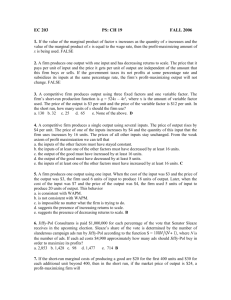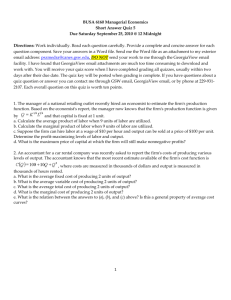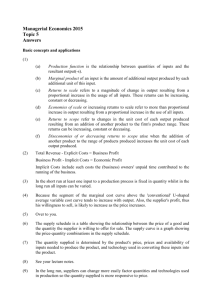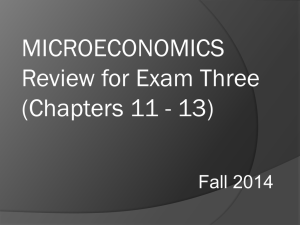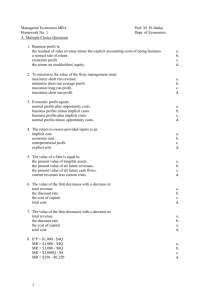ECON 2100 Practice C..
advertisement
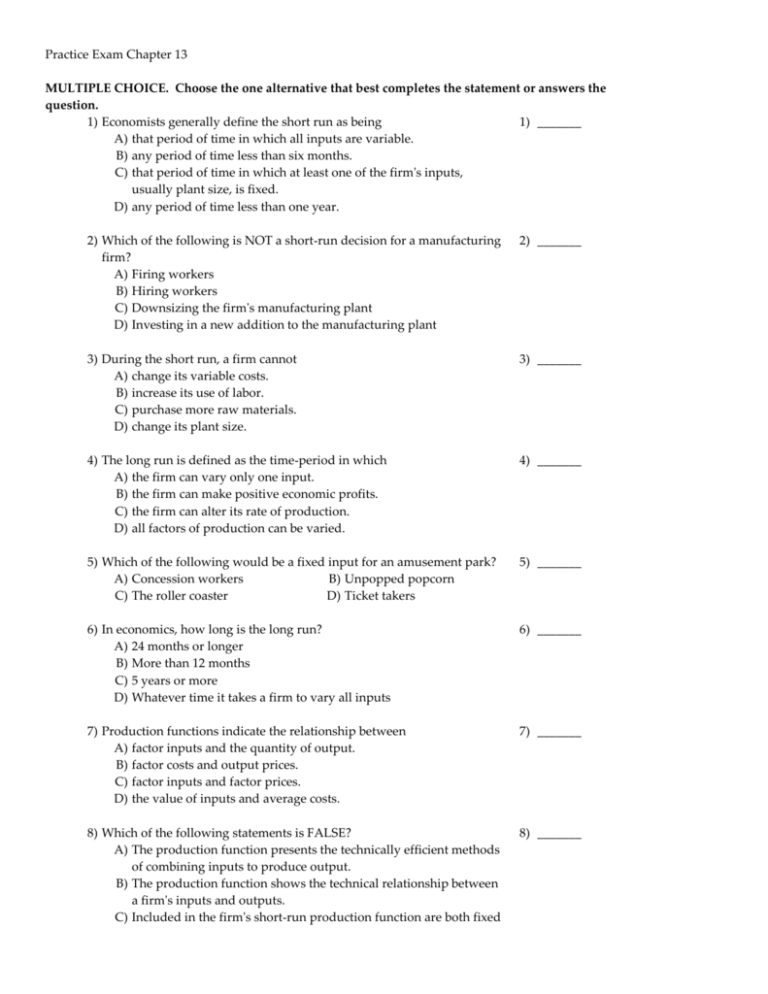
Practice Exam Chapter 13 MULTIPLE CHOICE. Choose the one alternative that best completes the statement or answers the question. 1) Economists generally define the short run as being 1) _______ A) that period of time in which all inputs are variable. B) any period of time less than six months. C) that period of time in which at least one of the firm's inputs, usually plant size, is fixed. D) any period of time less than one year. 2) Which of the following is NOT a short-run decision for a manufacturing firm? A) Firing workers B) Hiring workers C) Downsizing the firm's manufacturing plant D) Investing in a new addition to the manufacturing plant 2) _______ 3) During the short run, a firm cannot A) change its variable costs. B) increase its use of labor. C) purchase more raw materials. D) change its plant size. 3) _______ 4) The long run is defined as the time-period in which A) the firm can vary only one input. B) the firm can make positive economic profits. C) the firm can alter its rate of production. D) all factors of production can be varied. 4) _______ 5) Which of the following would be a fixed input for an amusement park? A) Concession workers B) Unpopped popcorn C) The roller coaster D) Ticket takers 5) _______ 6) In economics, how long is the long run? A) 24 months or longer B) More than 12 months C) 5 years or more D) Whatever time it takes a firm to vary all inputs 6) _______ 7) Production functions indicate the relationship between A) factor inputs and the quantity of output. B) factor costs and output prices. C) factor inputs and factor prices. D) the value of inputs and average costs. 7) _______ 8) Which of the following statements is FALSE? A) The production function presents the technically efficient methods of combining inputs to produce output. B) The production function shows the technical relationship between a firm's inputs and outputs. C) Included in the firm's short-run production function are both fixed 8) _______ and variable inputs. D) An efficient firm can obtain more output than the production function shows. 9) Which of the following WILL change a firm's production function? A) Acquiring additional physical capital B) Adopting new technology C) Hiring additional workers D) Adding a second production facility exactly like its first production site 9) _______ 10) A negative value for the marginal physical product would indicate that A) the company has not yet reached the point of saturation. B) total output decreased when the extra unit of the variable input was added. C) total output increased by a significant amount. D) total output increased, but the increase was very small. 10) ______ 11) In the above table, when the firm employs 4 workers, the marginal product will be A) 208 snowboards. B) 30 snowboards. C) 140 snowboards. D) 35 snowboards. 11) ______ 12) In the above table, diminishing marginal product occurs after employing the A) second worker. B) fourth worker. C) third worker. D) first worker. 12) ______ 13) In the short run, the additional output that results from hiring an additional unit of a variable input is the A) marginal physical product. B) marginal cost. C) average variable cost. D) average product. 13) ______ A firm has the following production relationship between labor and output, for a fixed capital stock. 14) According to the above table, what is the average product of labor when three laborers are employed? A) 3 B) 4 C) 5 D) 6 14) ______ 15) The firm's short-run costs contain A) only opportunity costs. C) only fixed costs. 15) ______ 16) Which of the following is correct? A) TC = FC + VC C) TC = FC - VC B) only variable costs. D) both variable and fixed costs. 16) ______ B) TC = FC / VC D) TC = FC * VC 17) Suppose that when the level of output for the firm increases from 100 to 110 units, its variable costs increase from $500 to $700. What is the firm's marginal cost? A) $20 B) $200 C) $7 D) $5 17) ______ 18) Which one of the following statements is FALSE? A) MC = TC divided by Q B) TC = TFC + TVC C) AFC = TFC divided by Q D) ATC = AFC + AVC 18) ______ 19) Assume it takes 10 units of labor to produce 4 units of output. When the price of labor is $6 per unit and fixed costs equal $60, what is the total cost of those 4 units of output? A) $60 B) $120 C) $70 D) $150 19) ______ 20) In economics, a fixed cost is a cost that A) goes up as the level of output goes up. B) does not vary with the level of output. C) goes down as the level of output goes up. D) is present only in the short run. 20) ______ 21) Which of the following would NOT be considered a fixed cost of production? A) Interest payments on a loan B) Insurance payments on plant and equipment C) Wages paid to labor D) The opportunity cost of capital 21) ______ 22) When output is 100 units, the firm's total fixed cost is $500. What will this firm's total fixed cost be if output doubles to 200 units? A) $500 B) $1,000 C) $250 D) Can't tell from the information provided 22) ______ 23) In the above figure, if this firm produces output level Q2, it has average variable costs of A) OE. B) OF. C) OC. 23) ______ D) OD. 24) Marginal cost begins to rise when A) fixed cost falls. B) diminishing marginal product begins. C) average total cost falls. D) diminishing marginal product ends. 24) ______ 25) If the marginal product of an input factor is falling, then A) average total cost is constant. B) marginal cost is falling. C) marginal cost is rising. D) average fixed cost is constant. 25) ______ 26) The long-run average cost curve A) is identical to the marginal cost curve. B) should always be horizontal. C) is a curve which is tangent to each member of a set of short-run average cost curves. D) is always a downward-sloping straight line. 26) ______ 27) In the above figure, for any output level less than Q2, this firm 27) ______ experiences A) B) C) D) constant economies of scale. decreasing long run average costs. economies of scale. diseconomies of scale. 28) Economies of scale exist where the long-run average cost curve is A) tangent to the marginal cost curve. B) upward sloping. C) horizontal. D) downward sloping. 28) ______ 29) Diseconomies of scale occur A) only in the short run. C) only in the long run. 29) ______ B) because of fixed costs. D) none of the above. 30) A horizontal long-run average cost curve indicates A) constant marginal physical product. B) diseconomies of scale. C) constant returns to scale. D) economies of scale. 30) ______ 31) When increasing its output results in falling costs, a firm that can adjust all inputs is experiencing A) capital gains. B) diseconomies of scale. C) loss. D) economies of scale. 31) ______ 32) Accounting costs represent A) both sunk and future costs. B) explicit costs paid by the firm. C) long run costs only. D) opportunity costs. 32) ______ 33) Implicit costs are measured by A) actual expenses paid by the firm. B) comparing the compensation packages of the CEOs in the industry. C) total revenues minus total costs. D) the value of alternative uses of the resources used in production. 33) ______ 34) The implicit cost incurred by a firm to use its resources to produce its output is the firm's A) total cost. B) explicit cost. C) accounting cost. D) opportunity cost. 34) ______ 35) Which is the best example of a firm's implicit costs? A) The opportunity cost of owner-provided labor B) Taxes C) Wages D) Rent 35) ______ 36) Economic profits equal A) accounting profits. 36) ______ B) accounting profits plus the owner's labor opportunity costs. C) total revenue less the opportunity costs of all factors of production. D) accounting profits less economic rents. 37) If the explicit costs to a firm to produce a unit of output are $6 and the firm sells 200,000 units of output for $9 per unit, the accounting profit received by the producer is A) $1.2 million. B) $600,000. C) $1.8 million. D) $850,000. 37) ______ 38) Suppose a family-owned yogurt shop has $80,000 in total revenues, $36,000 in rent, and $20,000 in additional operating costs. The husband and wife work in the shop and pay no wages to themselves or others. The economic profits from the shop are A) more than $24,000. B) $24,000. C) less than $24,000. D) $80,000. 38) ______ 39) Economic profits are equal to A) total revenues, after tax, minus cost of goods sold. B) total revenues minus total fixed costs. C) total revenues minus the implicit and explicit costs of all inputs used. D) total revenues minus the opportunity cost of labor. 39) ______ 40) Accounting profit is equal to A) total revenue minus implicit costs. B) dividends paid. C) total revenue minus explicit costs. D) total revenue minus dividends and interest. 40) ______ 1) 2) 3) 4) 5) 6) 7) 8) 9) 10) 11) 12) 13) 14) 15) 16) 17) 18) 19) 20) 21) 22) 23) 24) 25) 26) 27) 28) 29) 30) 31) 32) 33) 34) 35) 36) 37) 38) 39) 40) C D D D C D A D B B B C A D D A A A B B C A A B C C C D C C D B D D A C B C C C

